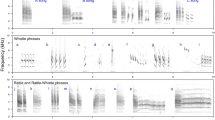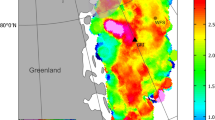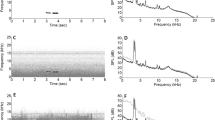Abstract
In many contexts, animals assess each other using signals that vary continuously across individuals and, on average, reflect variation in the quality of the signaller1,2. It is often assumed that signal receivers perceive and respond continuously to continuous variation in the signal2. Alternatively, perception and response may be discontinuous3, owing to limitations in discrimination, categorization or both. Discrimination is the ability to tell two stimuli apart (for example, whether one can tell apart colours close to each other in hue). Categorization concerns whether stimuli are grouped based on similarities (for example, identifying colours with qualitative similarities in hue as similar even if they can be distinguished)4. Categorical perception is a mechanism by which perceptual systems categorize continuously varying stimuli, making specific predictions about discrimination relative to category boundaries. Here we show that female zebra finches (Taeniopygia guttata) categorically perceive a continuously variable assessment signal: the orange to red spectrum of male beak colour. Both predictions of categorical perception5 were supported: females (1) categorized colour stimuli that varied along a continuum and (2) showed increased discrimination between colours from opposite sides of a category boundary compared to equally different colours from within a category. To our knowledge, this is the first demonstration of categorical perception of signal-based colouration in a bird, with implications for understanding avian colour perception and signal evolution in general.
This is a preview of subscription content, access via your institution
Access options
Access Nature and 54 other Nature Portfolio journals
Get Nature+, our best-value online-access subscription
$29.99 / 30 days
cancel any time
Subscribe to this journal
Receive 51 print issues and online access
$199.00 per year
only $3.90 per issue
Buy this article
- Purchase on Springer Link
- Instant access to full article PDF
Prices may be subject to local taxes which are calculated during checkout



Similar content being viewed by others
References
Maynard Smith, J. & Harper, D. Animal Signals (Oxford Univ. Press, Oxford, 2003).
Searcy, W. A. & Nowicki, S. The Evolution of Animal Communication (Princeton Univ. Press, Princeton, 2005).
Roff, D. A. The evolution of mate choice: a dialogue between theory and experiment. Ann. NY Acad. Sci. 1360, 1–15 (2015).
Bornstein, M. H. in Categorical Perception: the Groundwork of Cognition (ed. Harnad, S. R.) 287–300 (Cambridge Univ. Press, Cambridge, 1987).
Studdert-Kennedy, M., Liberman, A. M., Harris, K. S. & Cooper, F. S. Motor theory of speech perception: a reply to Lane’s critical review. Psychol. Rev. 77, 234–249 (1970).
Liberman, A. M., Harris, K. S., Hoffman, H. S. & Griffith, B. C. The discrimination of speech sounds within and across phoneme boundaries. J. Exp. Psychol. 54, 358–368 (1957).
Baugh, A. T., Akre, K. L. & Ryan, M. J. Categorical perception of a natural, multivariate signal: mating call recognition in túngara frogs. Proc. Natl Acad. Sci. USA 105, 8985–8988 (2008).
Wyttenbach, R. A., May, M. L. & Hoy, R. R. Categorical perception of sound frequency by crickets. Science 273, 1542–1544 (1996).
Nelson, D. A. & Marler, P. Categorical perception of a natural stimulus continuum: birdsong. Science 244, 976–978 (1989).
Wright, A. A. & Cumming, W. W. Color-naming functions for the pigeon. J. Exp. Anal. Behav. 15, 7–17 (1971).
von Frisch, K. Bees: Their Vision, Chemical Senses, and Language (Cornell Univ. Press, Ithaca, 1964).
Sandell, J. H., Gross, C. G. & Bornstein, M. H. Color categories in macaques. J. Comp. Physiol. Psychol. 93, 626–635 (1979).
Jones, C. D., Osorio, D. & Baddeley, R. J. Colour categorization by domestic chicks. Proc. R. Soc. B 268, 2077–2084 (2001).
Hanley, D. et al. Egg discrimination along a gradient of natural variation in eggshell coloration. Proc. R. Soc. B 284, 20162592 (2017).
Harnad, S. R. Categorical Perception: the Groundwork of Cognition (Cambridge Univ. Press, Cambridge, 1987).
Calder, A. J., Young, A. W., Perrett, D. I., Etcoff, N. L. & Rowland, D. Categorical perception of morphed facial expressions. Vis. Cogn. 3, 81–118 (1996).
Endler, J. A. Natural and sexual selection on color patterns in poeciliid fishes. Environ. Biol. Fishes 9, 173–190 (1983).
Hill, G. E. Female house finches prefer colourful males: sexual selection for a condition-dependent trait. Anim. Behav. 40, 563–572 (1990).
Hill, G. E., Montgomerie, R., Inouye, C. Y. & Dale, J. Influence of dietary carotenoids on plasma and plumage colour in the house finch: intra- and intersexual variation. Funct. Ecol. 8, 343–350 (1994).
Borel, P. Genetic variations involved in interindividual variability in carotenoid status. Mol. Nutr. Food Res. 56, 228–240 (2012).
Blount, J. D., Metcalfe, N. B., Birkhead, T. R. & Surai, P. F. Carotenoid modulation of immune function and sexual attractiveness in zebra finches. Science 300, 125–127 (2003).
George, D. B., Schneider, B. C., McGraw, K. J. & Ardia, D. R. Carotenoids buffer the acute phase response on fever, sickness behavior and rapid bill color change in zebra finches. J. Exp. Biol. 220, 2957–2964 (2017).
Collins, S. A. & ten Cate, C. Does beak colour affect female preference in zebra finches? Anim. Behav. 52, 105–112 (1996).
Burley, N. & Coopersmith, C. B. Bill color preferences of zebra finches. Ethology 76, 133–151 (1987).
Collins, S. A., Hubbard, C. & Houtman, A. M. Female mate choice in the zebra finch — the effect of male beak colour and male song. Behav. Ecol. Sociobiol. 35, 21–25 (1994).
Birkhead, T. R., Fletcher, F. & Pellatt, E. J. Sexual selection in the zebra finch Taeniopygia guttata: condition, sex traits and immune capacity. Behav. Ecol. Sociobiol. 44, 179–191 (1998).
Vorobyev, M. & Osorio, D. Receptor noise as a determinant of colour thresholds. Proc. R. Soc. B 265, 351–358 (1998).
Lind, O. Colour vision and background adaptation in a passerine bird, the zebra finch (Taeniopygia guttata). R. Soc. Open Sci. 3, 160383 (2016).
Hempel de Ibarra, N., Giurfa, M. & Vorobyev, M. Discrimination of coloured patterns by honeybees through chromatic and achromatic cues. J. Comp. Physiol. A 188, 503–512 (2002).
Osorio, D. & Vorobyev, M. Photoreceptor spectral sensitivities in terrestrial animals: adaptations for luminance and colour vision. Proc. R. Soc. B 272, 1745–1752 (2005).
Riggs, L. A., Blough, P. M. & Schafer, K. L. Electrical responses of the pigeon eye to changes in wavelength of the stimulating light. Vision Res. 12, 981–991 (1972).
Boogert, N. J., Anderson, R. C., Peters, S., Searcy, W. A. & Nowicki, S. Song repertoire size in male song sparrows correlates with detour reaching, but not with other cognitive measures. Anim. Behav. 81, 1209–1216 (2011).
Endler, J. A. & Mielke, P. W. Comparing entire colour patterns as birds see them. Biol. J. Linn. Soc. 86, 405–431 (2005).
Bennett, A. T. D., Cuthill, I. C., Partridge, J. C. & Maier, E. J. Ultraviolet vision and mate choice in zebra finches. Nature 380, 433–435 (1996).
Hunt, S., Cuthill, I. C., Swaddle, J. P. & Bennett, A. T. D. Ultraviolet vision and band-colour preferences in female zebra finches, Taeniopygia guttata. Anim. Behav. 54, 1383–1392 (1997).
Balkenius, A. & Kelber, A. Colour constancy in diurnal and nocturnal hawkmoths. J. Exp. Biol. 207, 3307–3316 (2004).
Stoddard, M. C. & Prum, R. O. Evolution of avian plumage color in a tetrahedral color space: a phylogenetic analysis of new world buntings. Am. Nat. 171, 755–776 (2008).
R Core Team. R: A Language and Environment for Statistical Computing http://www.R-project.org/ (R Foundation for Statistical Computing, Vienna, 2016).
Bates, D., Mächler, M., Bolker, B. & Walker, S. Fitting linear mixed-effects models using lme4. J. Stat. Softw. 67, 1–48 (2015).
Vorobyev, M., Osorio, D., Bennett, A. T. D., Marshall, N. J. & Cuthill, I. C. Tetrachromacy, oil droplets and bird plumage colours. J. Comp. Physiol. A 183, 621–633 (1998).
Acknowledgements
We thank D. Osorio for comments on the manuscript; L. Jin, K. Kochvar, J. Bollinger and L. Deehan for assistance running trials; and R. Mooney and M. Booze for providing access to zebra finches from their colony. Funding for this study was provided by the Duke University Office of the Provost.
Reviewer information
Nature thanks A. Kelber and the other anonymous reviewer(s) for their contribution to the peer review of this work.
Author information
Authors and Affiliations
Contributions
S.N. conceived and led the project, and secured funding; E.M.C., P.A.G. and M.N.Z. designed and carried out behavioural experiments, with assistance from S.P.; S.J. led the visual modelling and colour vision aspects of the study, with assistance from E.M.C. and P.A.G.; M.N.Z. conducted statistical analyses; P.A.G. prepared figures with assistance from M.N.Z.; S.P. managed the zebra finch population; E.M.C. wrote the initial draft of the manuscript, which was subsequently edited and approved by all authors.
Corresponding author
Ethics declarations
Competing interests
The authors declare no competing interests.
Additional information
Publisher’s note: Springer Nature remains neutral with regard to jurisdictional claims in published maps and institutional affiliations.
Extended data figures and tables
Extended Data Fig. 1 Downwelling vector irradiance at the level of the foraging grid.
Units are photons per cm2 per nm. Tungsten bulbs were used to illuminate each cage from a set distance. There was some variation in irradiance between cages. The blue line represents the mean absolute irradiance of our halogen bulbs, and the grey-shaded region indicates one standard deviation in either direction. The orange line illustrates standard Illuminant A, which we used throughout for visual modelling because it is a standard spectrum (and thus repeatable by other researchers) and closely matched the ambient lighting in our room.
Extended Data Fig. 2 Reflected radiance of experimental stimuli under experimental lighting conditions.
Reflected radiance is in arbitrary energy units; stimulus is Munsell paper covered with an epoxy cover. Below 400 nm, the values are so low that they reach the noise floor of the spectrometer, suggesting that the use of a trichromatic model (versus one that includes ultraviolet sensitivity) to examine chromatic distance between colours is appropriate.
Extended Data Fig. 3 Results from one-apart discrimination trials.
a, b, Results show data across all birds (a) and for each bird individually (b). Overall, birds performed more poorly at all one-apart tasks compared to two- or three-apart tasks, perhaps suggesting that colours that are one step apart neared the physiological limit of colour discrimination. However, the pass rate for the 5|6 comparison (which crossed the category boundary; green box, grey-shaded area) was significantly higher than for comparisons that did not cross the category boundary (white-shaded areas; blue boxes) (paired t-test, t24 = 4.09, P < 0.01). Numbers in parentheses inside boxes are number of birds that participated in each type of comparison. Box plots depict the median (horizontal line inside the box), 25th and 75th percentiles (box), 25th and 75th percentiles ±1.5× interquartile range (whiskers) and outliers (circles). The horizontal grey line represents the expected pass frequency if birds flip discs by chance. Numbers in square brackets are Michelson contrast for a given colour pair.
Extended Data Fig. 4 Results from three-apart discrimination trials.
a, b, Results show data across all birds (a) and for each bird individually (b). Pass rate was significantly higher for the three comparisons that crossed the boundary (3|6, 4|7 and 5|8; green boxes, grey-shaded area) than for those that did not (1|4 and 2|5; blue boxes, white-shaded area) (paired t-test, t25 = 6.07, P < 0.001). Numbers in parentheses inside boxes are number of birds that participated in each type of comparison. Box plots depict the median (horizontal line inside the box), 25th and 75th percentiles (box), 25th and 75th percentiles ±1.5× interquartile range (whiskers) and outliers (circles). The horizontal grey line represents the expected pass rate if birds flip discs by chance. Numbers in square brackets are Michelson contrast values for a given colour pair.
Extended Data Fig. 5 Results from greyscale (that is, hue information removed) one-apart discrimination experiments.
These greyscale experiments did not replicate the categories that we observed when hue information was included, indicating that categories are not structured based on brightness alone. Box plots depict the median (horizontal line inside the box), 25th and 75th percentiles (box), 25th and 75th percentiles ±1.5× interquartile range (whiskers) and outliers (circles). Numbers in parentheses below each comparison are Michelson contrast values. Linear mixed models showed that, in our greyscale experiments (that is, without chromaticity information), Michelson contrast between greyscale pairs significantly predicted pass rate. This finding is consistent with the possibility that category formation may be the result of both chromaticity and brightness information (see Table 1). Sample size was 18 birds for all comparisons.
Extended Data Fig. 6 Wavelength discrimination of avian photoreceptors.
The wavelength discrimination function of the pigeon C. livia (black dashed line) plotted against the spectral sensitivity peaks of the zebra finch (green, red, blue lines). Original data for the electroretinography-derived wavelength discrimination function are from Riggs et al.31 and have been inverted so that higher numbers indicate greater discrimination.
Extended Data Fig. 7 Schematic illustrating differences between continuous and categorical perception.
Under continuous perception (solid line), receivers perceive and respond in a continuous fashion to signal variation, meaning that any change in a signalling trait is associated with a concomitant change in receiver response. Under categorical perception (dashed line), such as described here for female zebra finches, receivers show enhanced discrimination of variants across a boundary (hash marks on x axis) compared to equally spaced variants within a category. Zebra finch line drawing by N. Silina licensed under a Attribution 4.0 International (CC BY 4.0) licence (http://supercoloring.com/pages/zebra-finch).
Supplementary information
Supplementary Information
This file contains an SI Guide providing descriptions for sheets 1-6 in the Supplementary Table file.
Supplementary Table
This file contains data regarding spectra and sensitivity curves.
Rights and permissions
About this article
Cite this article
Caves, E.M., Green, P.A., Zipple, M.N. et al. Categorical perception of colour signals in a songbird. Nature 560, 365–367 (2018). https://doi.org/10.1038/s41586-018-0377-7
Received:
Accepted:
Published:
Issue Date:
DOI: https://doi.org/10.1038/s41586-018-0377-7
This article is cited by
-
Are red-crested cardinals Paroaria coronata (Aves: Thraupidae) truly monomorphic?: evidence discloses sexual dichromatism and size differences since the nestling stage
Journal of Ornithology (2024)
-
Corvids optimize working memory by categorizing continuous stimuli
Communications Biology (2023)
-
Learning without a brain: classical conditioning in the ophiuroid Ophiocoma echinata
Behavioral Ecology and Sociobiology (2023)
-
Composition and compound proportions affect the response to complex chemical signals in a spiny lizard
Behavioral Ecology and Sociobiology (2021)
-
Connectivity between nidopallium caudolateral and visual pathways in color perception of zebra finches
Scientific Reports (2020)
Comments
By submitting a comment you agree to abide by our Terms and Community Guidelines. If you find something abusive or that does not comply with our terms or guidelines please flag it as inappropriate.



